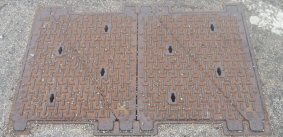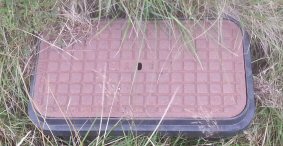

Note: This section now only includes background that was not included in the FTTC Submission ...


The cable ducting out to Shinness probably follows the road route out to us - that is, down Church Hill Road, turning right down Main Street, and right again out towards Shinness. What is certain is that from the town boundary, you can pick out and follow the manholes outwards along the main road - usually one every 150m or so, occasionally closer or further apart, rectangular units about 2m x 1m with four cast-iron triangular 1/4 covers, usually set in the verge, but occasionally in the road surface itself (top picture). Beyond Woodside, 5 West Shinness and in the side roads, there is a different arrangement where cables are 'buried', using the term rather loosely, directly into the verge and instead of manholes there are smaller, self-contained concrete or plastic oblong inspection chambers with concrete or cast-iron covers (bottom picture) - there's usually one on the verge outside each property, possibly at the foot of a pole with a drop-wire to the property, but many premises now have the better arrangement of the last link being buried right up to the property itself (drop-wires are considered undesirable because they are vulnerable to chafing in stormy winds and consequent failure).
I have heard from two different sources that there may already be fibre, or at least ducting for it, along the main road to Durness, but hard information on this is proving hard to obtain. Additionally, extensive searches online have not revealed anything that supports this rumour.
Online graphs and calculators predicting broadband Asymmetric Digital Subscriber Line (ADSL)
speed given the distance to the exchange, for example this one …
http://www.increasebroadbandspeed.co.uk/2012/graph-ADSL-speed-versus-distance
… tend to give up at around 5 or 6km, and using the …
BT Broadband Availability Checker
… to check ADSL speeds expected across the neighbourhood results in an unhelpful blanket response
of 'up to 1Mbps' regardless of actual location chosen within it!
More importantly, this uncertainty is compounded by there being a shortage of information as to what actual speeds are being obtained across the neighbourhood. Of those kind enough to respond to my original leaflet, a majority of more than 30, the 8 who gave any indication of their actual current landline speeds varied between being unable to receive landline broadband at all, or preferring an alternative because of the low speeds and low reliability of a landline connection at their property - most of these had gone for a satellite connection - through a lowest landline connection speed of 0.6Mbps, an average of 0.9Mbps, to an exceptional highest of 2.5Mbps.